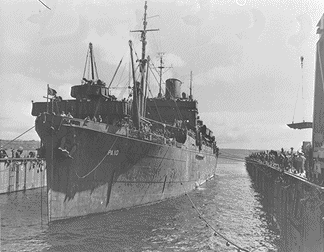| |
Commissioned Service
 The USS Harry Lee spent the first few
months of her commissioned service transporting Marine combat units
to the Caribbean for training exercises, helping to build
the amphibious teams which were to find such great success
in the later stages of World War II. The USS Harry Lee spent the first few
months of her commissioned service transporting Marine combat units
to the Caribbean for training exercises, helping to build
the amphibious teams which were to find such great success
in the later stages of World War II.
After a stay at Norfolk, the transport was assigned in
July to the Iceland route, carrying troops
and supplies to that country from Norfolk and New York.
After making two such passages, she returned to Boston
on December 22, 1941, to take part in additional
training exercises.
With America then in the war, the Harry Lee spent the
next 18 months in amphibious maneuvers in the Caribbean
area. During this time training exercises were
carried out in landing craft and boat control
procedures, all of which bore fruit in the dangerous
months to come.
Mediterranean Fleet Service
Returning to Boston on April 6, 1943, the Harry Lee was
designated for use in the upcoming offensive in the
Mediterranean, and sailed June 8, 1943, for Algeria.
She anchored at Oran on June 22, 1943 to prepare for the
landing and she found herself off the southwest coast of Sicily
on July 10, 1943, with Vice Admiral Hewitt's
Western Naval Task Force. During these giant invasions the
Harry Lee debarked her troops through the heavy surf at
Scoglitti and withstood several Axis air attacks before
retiring two days later.
Pacific Fleet Service
1943
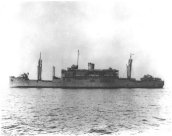 After the
success of the Sicilian operation, the transport returned
German
prisoners of war to the United States, arriving at
Norfolk on August 3, 1943. It was then decided that her
amphibious prowess was needed in the Pacific and
she sailed August 24, 1943 for Wellington, New
Zealand, via the Panama
Canal and San Francisco, arriving October 12, 1943. After the
success of the Sicilian operation, the transport returned
German
prisoners of war to the United States, arriving at
Norfolk on August 3, 1943. It was then decided that her
amphibious prowess was needed in the Pacific and
she sailed August 24, 1943 for Wellington, New
Zealand, via the Panama
Canal and San Francisco, arriving October 12, 1943.
At Wellington, the Harry Lee loaded Marines in
preparation for the big push of the invasion of the Gilbert
Islands. She proceeded to Efate,
New Hebrides, Nove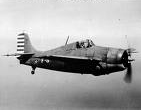 mber 1-7, 1943, and for the next
few weeks held amphibious practice landings in
preparation for the landings on Tarawa.
The transport departed for Tarawa on November 13, 1943,
and arrived offshore on November 20, 1943. There she
launched her Marines onto the bloody beaches, under
threat of submarine attack and air attack. In action
between November 20 and November 30, she buried 12
United States Marines at sea. The Harry Lee then sailed
on November 30th for Pearl Harbor. (See the declassified
after action report below.) mber 1-7, 1943, and for the next
few weeks held amphibious practice landings in
preparation for the landings on Tarawa.
The transport departed for Tarawa on November 13, 1943,
and arrived offshore on November 20, 1943. There she
launched her Marines onto the bloody beaches, under
threat of submarine attack and air attack. In action
between November 20 and November 30, she buried 12
United States Marines at sea. The Harry Lee then sailed
on November 30th for Pearl Harbor. (See the declassified
after action report below.)
1944
The Harry Lee participated in rehearsal landings in
Hawaiian waters after her arrival at Pearl
Harbor on December 7, 1943, the second anniversary
of the Japanese attack on Pearl Harbor, and sailed January
23, 1944 for the invasion of the Marshall
Islands, next step on the island road to
Japan.
She arrived off Kwajalein on January 31, 1944.
She effectively carried out her role in this complicated
operation by landing troops on two small islands in the
atoll; they met little opposition. The Harry Lee
remained off Kwajalein until departing for Funafuti on
February 5, 1944. From there she sailed to Noumea
on February 24, 1944 and by March 14, 1944, she was
anchored off Guadalcanal
to load troops and continue her amphibious preparation.
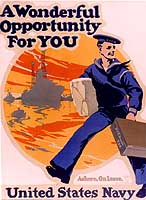 After carrying
troops to Bougainville and New
Guinea in April, the Harry Lee sailed to Aitape,
New Guinea, under Rear Admiral Barbey for the Hollandia
operation. She arrived April, 23, 1944, after the
initial assault, unloaded her troops, and proceeded to
bring reinforcements from other points in New Guinea to
the landing area. This accomplished, the transport
arrived in Espirtu Santo on May 11, 1944. After carrying
troops to Bougainville and New
Guinea in April, the Harry Lee sailed to Aitape,
New Guinea, under Rear Admiral Barbey for the Hollandia
operation. She arrived April, 23, 1944, after the
initial assault, unloaded her troops, and proceeded to
bring reinforcements from other points in New Guinea to
the landing area. This accomplished, the transport
arrived in Espirtu Santo on May 11, 1944.
The Harry Lee was next to take part in the invasion of
the Marianas.
After landing operations conducted around Guadalcanal
the ship sailed to Kwajalein and got underway in convoy
for Guam
on June 12, 1944. During this gigantic operation, in
which troops were projected over 1,000 miles of ocean
from the nearest advance base, the Harry Lee was held in
reserve for the Guam landings. She arrived off Agat,
Guam, on July 21, 1944 and debarked her troops. The
transport then remained offshore loading and relanding
troops for tactical purposes until July 25, 1944, when
she steamed with her fellow transports to Eniwetok.
They arrived on July 29, 1944, and two days later sailed
for Pearl Harbor.
Arriving Pearl Harbor on August 7, 1944, the Harry Lee
set course for California and a much-needed overhaul.
She arrived San Pedro on August 18, 1944 and remained in
California until departing on October 21, 1944, with
troops for Seeadler Harbor, Manus. Until December 31,
1944, the ship conducted practice landings in New Guinea
and the Solomons for the upcoming invasion of Luzon,
in the
Philippines, and departed the last day of
1944 for Lingayan Gulf. Enroute, Japanese planes
attacked the task force savagely with suicide planes and
bombers, but the Harry Lee by effective gunfire and luck
escaped damage.
1945
She entered Lingayen Gulf on January 9, 1945, and
began landing troops under constant air alert. That night
the transports retired off the beaches under smoke
screens, returning the next day to resume the dangerous
job of landing supplies. Harry Lee sailed on January 10,
1945, for Leyte Gulf, anchoring there on January
14, 1945.
With troops ashore at Lingayen, the Harry Lee departed
on January 19, 1945 for Ulithi,
northeast of Palau and southwest of Guam, and arrived
two days later. The ship went to Ulithi to take on fresh
water as there was a larg desalinization plant there.
She soon was back in action, however, sailing on
February 17, 1945, for Iwo Jima and her
last amphibious operation of the war. The
transport arrived via Guam on February 22, 1945, three
days after the landings , and after sending a
reconnaissance unit ashore on February 24, 1945,
disembarked her troops. The ship remained off Iwo Jima
until March 6, 1945, acting as a hospital evacuation
vessel. She then sailed with casualties to Saipan from
March 6-9, 1945.
This photo of the USS Harry
Lee was provided to me by Sherry Troupe who told
me she found it at a flee market. She collects old
WWII memorabilia, found our website and forwarded
it to me. One email I received thought this
picture was taken after the war because of the
large hull numbers. He said that during the war
hull numbers were kept small. A subsequent email
from Mr. Cruce Lansford stated that the photo was,
in fact, taken after the war in San Francisco
harbor. He said the ship was unloading boats
to leave them there and go to Brooklyn to
decommission. He states in his email, "I was
on the forward deck where the boat was hoisted. A
boat came out and took pictures then sold them to
us." Click the image for a larger view. More
images are in a catalog at the end of the website
under Further Resources.
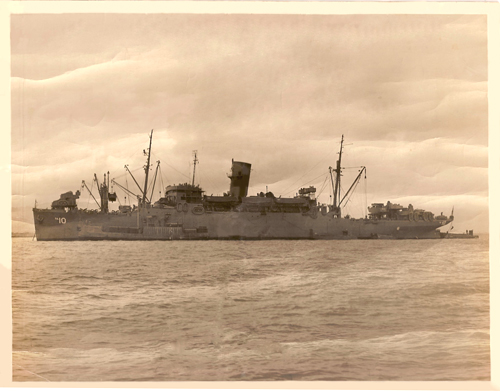
Harry Lee spent the rest of her time in the Pacific
transporting troops and supplies, as the American thrust
at Japan neared its final phase. She touched at Tulagi,
Noumea, New Guinea, Manus and the Philippines, bringing
reinforcements and vitally needed supplies. The ship was
at Leyte Gulf on July 20, 1945, when ordered back to the
United States and she arrived for a brief stay on August
8, 1945. It was during this time that news of
Japan's surrender 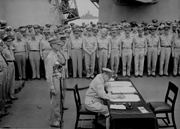 reached the veteran transport.
The surrender was signed aboard the battleship USS
Missouri in Tokyo Bay on Septebmer 2, 1945, as shown in
the photo at the right. reached the veteran transport.
The surrender was signed aboard the battleship USS
Missouri in Tokyo Bay on Septebmer 2, 1945, as shown in
the photo at the right.
The Planned Invasion of Japan
For a description of what might have happened if the
invasion of Japan had taken place, see An Invasion Not Found in
History Books, by James Martin Davis,
reprinted from the Omaha World Herald, November, 1987.
Bibliography
of the Planned Invasion
Noted military historian D. M. Giangreco has
graciously provided the USS Harry Lee website with an
excellent
bibliography and Internet links to articles
and lectures on the topic of the planned U.S.
invasion of Japan and it's probable consequences for
U.S. servicemen. Mr. Giangreco has published a paper specifically dealing
with how valuable troop transport ships like the USS
Harry Lee were to the war's successful conclusion.
The ship reached Manila on September 16, 1945,
and aided in the occupation of Japan,
and after loading troops at various points in the
Philippines arrived Tokyo Bay on October 13,
1945. Assigned to Operation Magic Carpet, and
the huge job of bringing American veterans home from the
Pacific, the Harry Lee arrived in San
Francisco on November 4, 1945, and made another
round trip to the Philippines
and back, arriving January 20, 1946.
1946
From San Francisco she sailed January 23, 1946, for New
York, via Norfolk. The ship arrived February 9, 1946, and
decommissioned at Brooklyn
Navy
Yard on May 9, 1946. After a period in Reserve
Fleet, she was sold to Turkey in April 1948.
Renamed the Tarsus, she burned in the
Bosporus after a rare three ship collision in
December, 1960.
Further USS Harry Lee Resources
The U.S.S. Harry Lee Pamphlet
 For more information about this fine ship and her crew
look at the other USS Harry Lee
web site especially for veterans who served aboard the
USS Harry Lee.
For more information about this fine ship and her crew
look at the other USS Harry Lee
web site especially for veterans who served aboard the
USS Harry Lee.
The pamphlet at the left was published on November
2, 1945 and contains many interesting facts about
the ship. The pamphlet has been scanned into an Adobe
Acrobat portable document file, (size 512 Mb). Be
patient as it takes awhile (a minute or serveral
minutes) to download even with a high speed Internet
connection. Click the following link to download the
file:
USSHarryLee.pdf
If you can't download the file email
me with your address and I will endeavor to
mail you the file on a CD ROM disk.
Declassified Tarawa After Action
Report 1943
Dated December 6, 1943, the U.S.S. Harry Lee
declassified Tarawa After Action Report was
graciously provided by Patrick L. Smith of Saxton,
Pennsylvania. It was submitted to CINCPAC and describes
in the cold, detached prose of that era the action of
the U.S.S. Harry Lee during the Tarawa invasion.
Diaries and Memoirs of Servicemen
The
Adventures
of a Landing Craft Coxswain is the very
interesting story of Sterling Funck who served
aboard the USS Harry Lee in WWII written by his grandson
Christian A. Funck.
The diary of
Alvan Fisher, a serving member of the
crew during 1941 and 1942, was graciously provided to me
for this website by his son, Alvan Fisher, Jr. You can
read the diary as a Word document (165 kb).
The personal navy log
of A. A. Maronta, a pharmacist's mate
serving aboard the USS Harry Lee, has been graciously
provided by his son, Mike Maronta. You can read this
personal navy log as an Adobe Acrobat Reader portable
document file (4.8 Mb).
The Six Long
Years - autobiographical observations of a
sailor who served on a destroyer in the Pacific during
the time the USS Harry Lee was in commission.
Letter from Donald Rouse - September 26, 2017
"I scan papers for veterans' obituaries, thinking
I might see one or two that I might have sailed
with. This morning's Appleton Post Crescent
newspaper has an obituary
for Emery J. Parker, age 92, who had saild on
the APA 10 USS Harry Lee.
Like Emery, I was a Navy Radioman, and I sailed
to many of the same ports that the USS Harry Lee
did. But my service was in the Navy's Armed Guard
aboard merchant ships. Six different "Liberty"
ships and a couple of T2
tankers. Even though I live in Menasha,
Wisconsin, where Mr. Parker had been living I was not
privileged to have met him." Donald Rouse
SS Henry Bergh ship information from Donald Rouse
- October 11, 2017
"The SS Henry Bergh was a Liberty
ship converted into a troop transport under the US
Army control. Another US Navy radioman and an Army
Sgt. were the 3 man radio crew on this ill fated
ship. The ship sailed from San Francisco on
April 4, 1944 to Port Hueneme (Oxnard, California)
where we took on about 1000 Seabees and lost of their
equipment. We sailed to Midway Island where we
were destined. After several days we loaded over
a thousand sailors and Marines who were headed
stateside for well deserved leave. We stopped at
Pearl Harbor where we took on another 300 or so.
Several days out from San Fransisco we ran into
the usual fog and it got thicker as we approached San
Fransisco. Actually thicker than i had
encountered on previous ships. Due to the fact
that our gyro compass was not working from the time we
left San Fransisco, the captain and navigator were
unable to find our position very accurately. But
overall I think they did a good job until we hit the
fog.
In the radio room we were called upon to send
out a continuous signal where 3 shore stations could
fix our position. We took 3 separate bearings.
The last one was just 40 minutes before we ran
aground on the Farallon Islands which are just
30 miles out from the Golden Gate bridge. The
time was set at 0530, May 31, 1944. The ship was
immediately lifted and dropped severely by the huge
ground swells breaking open the hull and causing sea
water to fill the engine room, knocking out our
electric power, and causing other damage.
I was sent ashore in the first life boat with a
portable transmitter and kept in contact with the
signalman aboard the ship who sent me messages using a
battery operated "blinker" light. In the
meantime the troops were being taken off the ship in
the few life boats and rafts that could be
lowered. There were no fatalities, but many
bruises and broken bones, etc. After about an
hour I was ordered back to the ship to assist with the
packing up of the ship's log, documents and other
things.
All of the survivors were then taken by small
craft to San Francisco, Treasure Island and Mare
Island. Most were given a 15 day survivor leave.
Three of us radiomen were detained for 3 days along
with the Merchant Marine officers by the US Coast
Guard to investigate the cause of the maritime
accident. The radiomen from the three shore
stations that we worked with prior to our going
aground were called in to testify and corroborate the
position messages we gave to the captain. This
fully exonerated us radiomen. The ship broke in
half in the next 24 hours. Captain Chambers had
his captain's license suspended for a 5 year period.
Ships
that Donald Rouse served on:
1. SS James
Cook
2. SS Henry Bergh - Liberty ship
3. SS Mission Buena Ventura - Tanker
4. SS Samuel Lancaster - Liberty ship
5. SS Seven Pines - Tanker
6. SS Mariscal Sucre - Liberty ship
7. SS Fairisle - Liberty ship
We
were all taken off the SS Mariscal Sucre in Tsingtao,
China, November 1, 1945 and put aboard a converted
troop ship and there followed 31 "rough, stormy days
to Seattle and then another 15 days to get to Kirkland,
Washington, just across Lake Washington from Seattle
proper. We though Kirkland was a very nice town.
There we awaited transportation to the Great Lakes for
discharge." - Donald Rouse
National Archives Photographs
A gentleman from Falls Church, Virginia, provided me
with copies of photographs released by the National
Archives of the U.S.S. Harry Lee, (AP 17,
reclassified APA 10 on February 1, 1943). The
photographs span the time between 1941 and 1945. You
view a small catalog of these photographs here.
Click on the thumbnail images to view the larger scanned
images.
Commanding Officers of the USS Harry Lee
| Robert Paul Hinrichs |
USNA 1911 |
Captain |
Dec 12, 1940 |
| Joseph G. Pomeroy |
|
Commander |
Feb 1943 |
| James W. Whitfield |
USNA 1919 |
Capt:RAdm |
Mar 1943 |
| Dwight Merle Agnew |
USNA 1926 |
Capt:RAdm |
No date |
| |
|
|
|
USNA stands for United States Naval Academy and the
year was the year that officer graduated from the Naval
Academy. This information on commanding officers was
kindly provided by Wolfgang
Hechler.
|
|
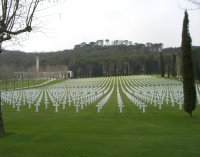
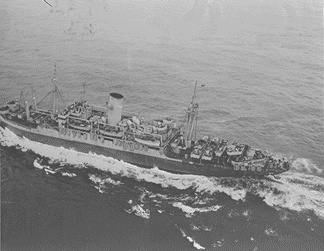

 The USS Harry Lee spent the first few
months of her commissioned service transporting
The USS Harry Lee spent the first few
months of her commissioned service transporting  After the
success of the Sicilian operation, the transport returned
German
prisoners of war to the United States, arriving at
Norfolk on August 3, 1943. It was then decided that her
amphibious prowess was needed in the Pacific and
she sailed August 24, 1943 for Wellington,
After the
success of the Sicilian operation, the transport returned
German
prisoners of war to the United States, arriving at
Norfolk on August 3, 1943. It was then decided that her
amphibious prowess was needed in the Pacific and
she sailed August 24, 1943 for Wellington, 
 After carrying
troops to Bougainville and
After carrying
troops to Bougainville and  reached the veteran transport.
The surrender was signed aboard the battleship USS
Missouri in Tokyo Bay on Septebmer 2, 1945, as shown in
the photo at the right.
reached the veteran transport.
The surrender was signed aboard the battleship USS
Missouri in Tokyo Bay on Septebmer 2, 1945, as shown in
the photo at the right. 
